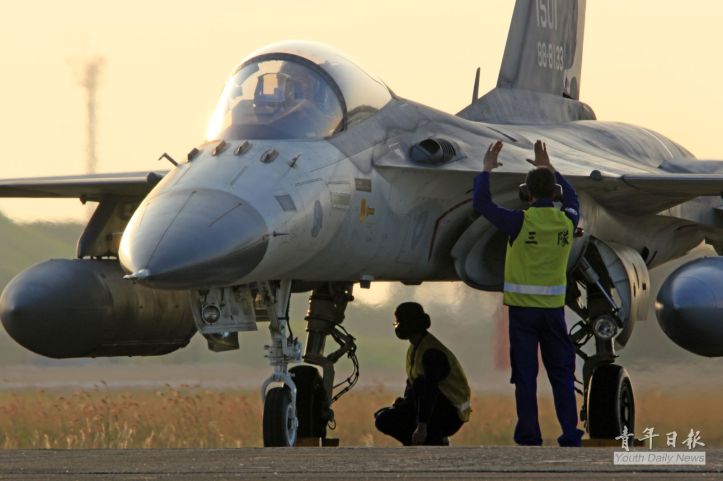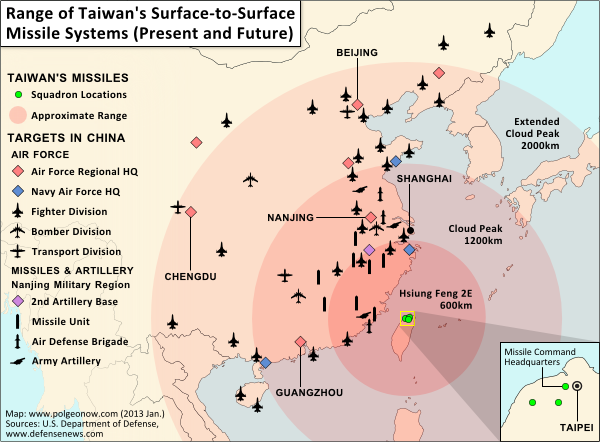Week in Taiwan Defense is a weekly overview of events relevant to Taiwan defense: interesting articles, commentary, and papers. Occasionally introducing older articles on ICWMI (in-case-we-missed-it) basis.
Focus on Taiwan’s defense development, People’s Liberation Army activity in the region, U.S.-Taiwan defense relations, and other political developments with relevance to Taiwan and its defense needs.
Issue 2 (8 January to 14 January 2018)

Global Taiwan Brief (Issue 1, Vol. 3) published by Global Taiwan Institute offers an excellent collection of five essays on reassessing Taiwan’s defense needs. It is the best you will read on Taiwan’s defense from last week.
GTI’s Russell Hsiao’s main point:
Despite Reagan’s clear directives in the NSC memo, there has been a gradual and creeping erosion in how Washington maintained Taiwan’s quantitative and qualitative edge over the PRC. As Chairman of the Joint Chief General John Dunford predicted in September 2017: “I think China probably poses the greatest threat to our nation by about 2025.” Reagan’s directives are more significant now than ever.
David An reviews Taiwan’s ambition to acquire submarines, U.S. role in the decision-making, and how a mix of factors eventually led to indigenous defense submarine (IDS) program:
A reassessment of US and Taiwan historical decision-making reveals how the Bush Administration’s 2001 decision to assist Taiwan with diesel electric submarines has been stalled for over a decade. Taiwan is now determined to produce submarines indigenously but US components and technology transfer approvals are critical to help Taiwan develop the most modern, technologically advanced, and capable submarines.
Joe Bosco looks back on the historical development that surrounded Nixon’s decision to recognize the People’s Republic of China and the implications it had for Taiwan. Bosco calls for U.S. clarity on Taiwan to avoid miscalculations that could lead to war.
The principal cause of the miscalculation leading to the Korean War may be found in the lack of clarity over US vital strategic interests in Asia. History will judge Nixon’s opening to China, and the decades of Western engagement that followed, as a valiant but flawed effort to turn world events in a positive strategic direction. Greater clarity may forestall future conflicts.
Richard Fisher brings to attention less known development from the 1980s. Back then, Taiwan pursued a sale of an F-5G/F-20 Tigershark, a substantial modernization of F-5E Tiger II fighter jet. However, Taiwan’s request was denied, and Taipei decided to proceed with indigenous defense fighter (IDF) program that resulted in AIDC F-1-CK. Fisher argues that the decision not to sell F-20s was a missed opportunity to signal Beijing that U.S. arms sales would not be dictated by Beijing.
If the United States had sold Taiwan the Northrop F-5G/F-20 in the early 1980s, Washington would have established much earlier in their rapprochement that Beijing could not dictate US arms sales to Taiwan. It would also have strengthened US credibility in Taipei during the painful transition to derecognition. The major policy lesson contained here is: let Taiwan arms sales be determined mainly by China’s threat.
Fu S. Mei of the NYC-based Taiwan Security Analysis Center takes a closer look at Taiwan’s counter-strike capability. First, Taiwan’s missile program has never been about achieving a strategic capability.
Taiwan realizes a relatively small number of precision-strike weapons would have only limited impact on China’s overall war-making capacity, but leadership also believes that even a moderate capability for attacking key ETC military targets would be valuable, since it could disrupt the PLA’s operational tempo, delaying achievement of Beijing’s political-military objectives. This would buy time for Taiwan to recover from initial Chinese strikes and for potential allies to evaluate/implement intervention options. Deep-interdiction capability may not win a war for Taiwan, but by increasing the uncertainty and cost of a PRC offensive, it could enhance deterrence.
The U.S. has generally been opposing Taiwan’s ambition to acquire offensive weapons, but that does not mean that counter-strike/deep strike capability has been entirely off the table.
Despite its thorny nature, Taipei did quietly discuss its “counter-strike” capabilities with Washington during the past decade, agreeing to a number of general principles, including using only conventionally-armed weapons and only using them against military targets in response to a PRC first strike, after proper (Taiwan presidential) authorization. That Taiwan officially refers to its LACM as the “Tactical Shore-based Missile for Fire Suppression” (TSMFS) testifies to this understanding.
Fu S. Mei offers insight into the development of a major missile programs under the National Chung Shan Institute of Science and Technology (NCSIST): a subsonic land-attack cruise missile (LACM), a tactical ballistic missile (TBM), and an air-launched cruise missile/munitions dispenser (ALCM), and a hybrid supersonic land-attack cruise missile (SLACM).
On LACM:
Development work began in the 1990s on a long-range, LACM that eventually became known as HF-2E.[…]Engine modifications and miniaturization of the missile’s guidance control elements (to free up internal volume/weight for additional fuel), have reportedly extended the missile’s range to 1,000km. While the NCSIST continues development of an ultimate version with 2,000-km range, options are now said to be available for the Tsai Administration to upgrade existing HF-2Es to the 1,000-km range configuration.
On TBM:
The ultimate goal is to develop a medium-range ballistic missile (1,000+ km range) with conventional payload. Even though media reports in 2014 claimed that the NCSIST already possessed capacity to produce solid rocket motors of up to 2-meter diameter, Taiwan is still years away from a viable MRBM. However, the MND recently announced directives to develop a battlefield support missile capability similar to that of MGM-140 ATACMS (Army TACtical Missile System), which has a 300km range and a 500-lb warhead, performance levels that fall within MTCR (Category 1) thresholds.
On SLACM:
Taiwan has reportedly invested over US $267 million (NT $8 billion) over the last decade to develop a supersonic land-attack cruise missile, known as Yun Feng (“Cloud Peak”; 雲峰).[…]In theory, the missile’s high cruising altitude (upwards of 70,000 ft.) and speed (Mach 3+) could aid penetration of enemy air defenses. However, unlike a TBM, with much higher typical terminal velocities (Mach 6 for DF-15, Mach 10 for DF-21), a SLACM is likely more vulnerable to interception. Yun Feng was reportedly ready for production by 2014, although the Ma Administration and, so far, also the Tsai Administration, have both shelved it, bowing to US pressure. Further development work appears to be continuing, however.
On ALCM:
In addition to surface-to-surface missiles, Taiwan has also successfully produced an air-launched cruise missile, in the form of the Wan Chien (“Myriad Swords”; 萬劍) standoff runway-attack weapon. This is a submunitions dispenser powered by turbofan engine and employing a combination of GPS/INS/TRN and terminal seeker guidance. Launch weight is under 2,000 lbs, with cruise speed of Mach 0.8+ and maximum range of 200+km.
Read the whole piece. It is at the moment the best piece on Taiwan’s missile program out there.
Related on Taiwan in Perspective:
- Porcupine’s Spines: Taiwan’s Indigenous Missile Program
- China’s neighbors embrace asymmetric warfare
- The best defense is a good offense: Taiwan’s counter-strike capability

Beijing’s unilateral opening of the M503 route (and 3 adjacent routes) for more commercial traffic continued to dominate Taiwan defense-related news last week.
Taiwan Sentinel’s J. Michael Cole argues that the international community cannot stay silent on Beijing’s attempts to destabilize the situation in the Taiwan Strait. The amount of commercial traffic makes risks stemming from unilateral decisions a concern for the international community.
With a total of 58 million passengers passing through Taiwan’s FIR every year, there is every incentive for the international community to try to minimize the risks of air accidents — after all, mid-air collisions do not care one bit for the political dispute in the Taiwan Strait, or for Beijing’s attempt to make a point due to the unwillingness of the Taiwanese to be cowed by its authoritarian neighbor.
However, Cole argues that the International Civil Aviation Organization (ICAO), whose head is Fang Liu, a Chinese national, is unlikely to intervene.
Taiwan in Perspective’s Michal Thim focuses on broader military implications of increased PLAAF activity and new developments on the M503 route. Chinese actions indicate that its salami slicing strategy could soon lead to Chinese disrespect of the median line in the Taiwan Strait.
A strong response risks unintended escalation; a weak response could mean that China’s continuous salami-slicing strategy will be successful. Taiwan could respond by sending its ELINT planes to China’s doorstep, but would China hesitate to shoot them down or otherwise harass Taiwanese patrol aircraft, potentially leading to a repeat of the Hainan Incident of 2001? There is no easy way to respond to such developments. And yet, PLAAF patrols disrespecting the median line and entering Taiwan’s ADIZ could soon become a reality, as Beijing will feel no moral constraints in breaching yet another agreement or tacit rule.
Mike Mazza of the American Enterprise Institute observes:
China’s behavior here evinces a determination to further unsettle the security environment in the Taiwan Strait and a willingness to do so with little regard for the safety of civil aviation. The actions of a responsible major power these are not.
China’s latest move also received strong condemnation in the U.S.: U.S. official slams China over M503 flight route action against Taiwan.
Ian Easton calls for closer Taiwan-U.S. defense cooperation in a piece published on (renewed) Taipei Times regular column On Taiwan.
To begin, US-Taiwan defense and security cooperation should be greatly strengthened. Washington should offer Taipei muscular new fighter jets, including F-16s and F-35s. Next, the two countries need to team together in the areas of undersea warfare, missile defense, cyber and electronic warfare, advanced missiles, and unmanned systems. Finally, other democracies should be brought into the joint effort. Japan, India and Australia are the most capable and willing.
The U.S. House of Representatives passed H.R.535 – Taiwan Travel Act. Summary of the act reads (emphasis added):
This bill states that it should be U.S. policy to: (1) allow officials at all levels of the U.S. government to travel to Taiwan to meet their Taiwanese counterparts; (2) permit high-level Taiwanese officials to enter the United States under respectful conditions and to meet with U.S. officials, including officials from the Department of State and the Department of Defense; and (3) encourage the Taipei Economic and Cultural Representative Office, and any other instrumentality established by Taiwan, to conduct business in the United States.
The bill, if passed by the Senate and signed by the President, does not create obligations for the administration. It would still be very much the Executive’s prerogative to conduct and allow such visits. However, the significance of the act is that it received extensive bi-partisan support (81 co-sponsors from both sides of the aisle) and was passed unanimously. House also passed a bill that directs the US secretary of state to help Taiwan regain its observer status at the WHO.
Other news:
- Taiwan might be acquiring 60 45-ton high-speed missile boats as a part of asymmetric means aimed at countering China’s military modernization. The project would be developed domestically.
- Taiwan President Tsai Ing-wen announced that the defense budget will increase by 20 percent by 2025. Weapons acquisition focus will be on indigenous development and purchase of advanced weapons from the US.
- F-CK-1 fighter jets will be equipped with additional Sky Sword 2 (天劍二) air-to-air missile with beyond-visual-range capability.
- China’s sole operational aircraft carrier passed through the Taiwan Strait last week. Taiwan responded with the deployment of a frigate and F-16 fighters to monitor Chinese navy moves.
Recommendation:
Follow @taiwandefense account maintained by US-Taiwan Business Council.